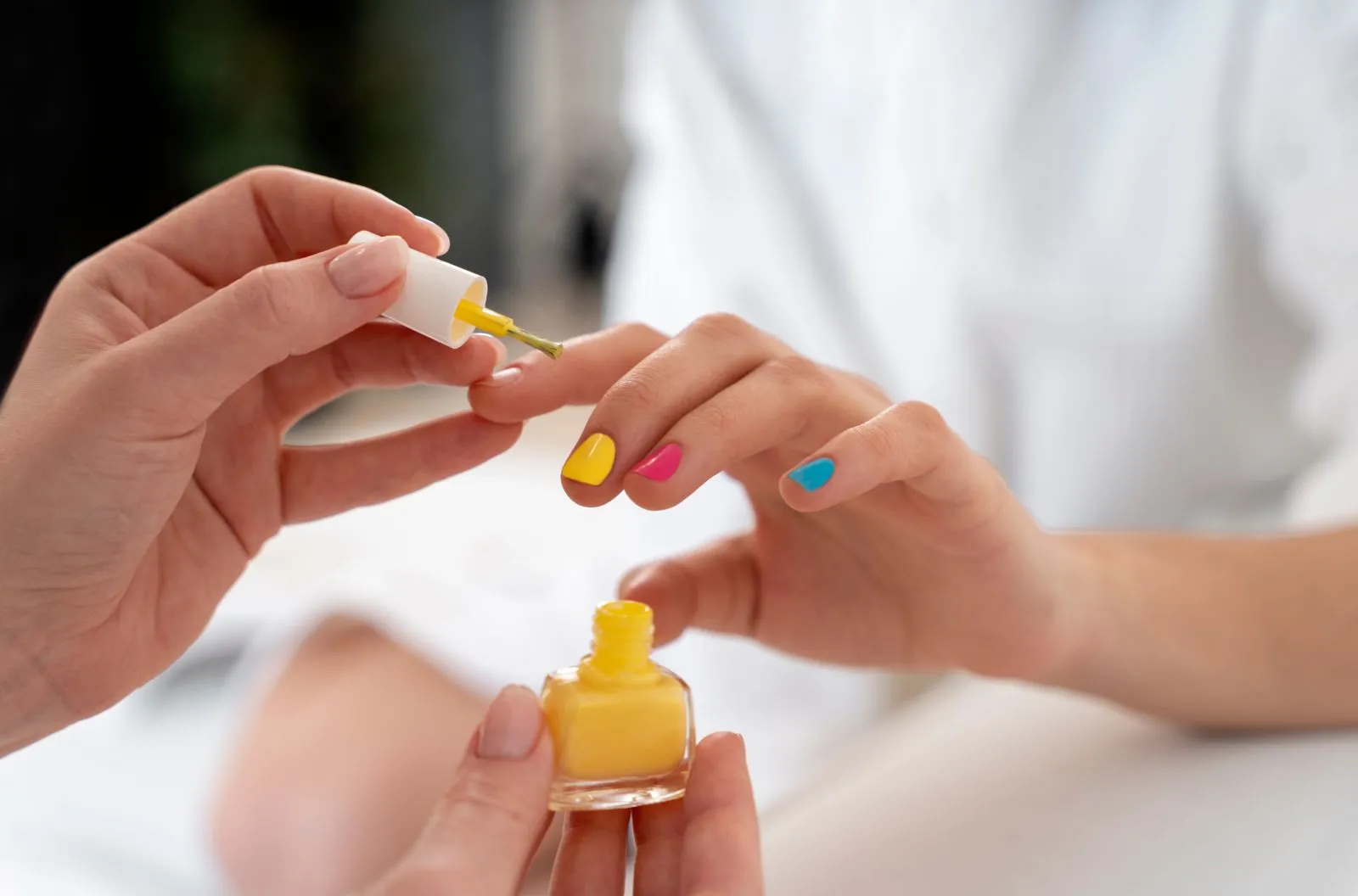TABLE OF CONTENTS
TABLE OF CONTENTS
When it comes to nail enhancements, acrylic and gel nails are two of the most popular options. Both offer beautiful, long-lasting results, but they differ significantly in terms of application, durability, and overall experience. Understanding these differences can help you make an informed decision about which type of nails suits your needs and lifestyle best.
Definition and Composition: Acrylic Nails vs. Gel Nails
Acrylic Nails
Acrylic nails are made from a combination of liquid monomer and powder polymer. When these two components are mixed, they form a hard, protective layer that can be shaped and styled over the natural nail. The chemical reaction between the monomer and polymer causes the mixture to harden quickly, making acrylic nails durable and strong.
Gel Nails
Gel nails, on the other hand, are made from a gel-like substance that is applied to the nails and then cured under a UV or LED light. The gel can be either a soft gel, which is more flexible and easier to remove, or a hard gel, which is stronger and more durable. Gel nails are known for their glossy finish and natural appearance.
Process of Application: Acrylic Nails vs. Gel Nails
Acrylic Nails
Preparation: The natural nails are cleaned, trimmed, and filed. The surface of the nails is buffed to remove any shine.
Application: A nail tip or form is applied if length is desired. The acrylic mixture (monomer and polymer) is then applied to the nails, sculpting it into the desired shape.
Drying: Acrylic nails air dry and harden within minutes.
Finishing: Once the acrylic has hardened, the nails are filed and buffed to the desired shape and smoothness. Nail polish or other decorations can then be applied.
Gel Nails
Preparation: Similar to acrylic nails, the natural nails are cleaned, trimmed, and filed, and the surface is buffed.
Application: The gel is applied in thin layers. Each layer must be cured under a UV or LED light for 30-60 seconds.
Layering: This process is repeated for 2-3 layers to achieve the desired thickness and strength.
Finishing: The nails are filed and shaped, and a final top coat is applied and cured for extra shine and durability.
Benefits: Acrylic Nails vs. Gel Nails
Acrylic Nails
Strength: Acrylic nails are renowned for their incredible strength and durability. This makes them an excellent choice for individuals who use their hands frequently, whether for work or hobbies. The robustness of acrylics helps them withstand daily wear and tear without chipping or breaking easily, providing a long-lasting solution for nail enhancement.
Versatility: Acrylic nails offer a high degree of versatility in terms of design and style. They can be easily shaped to any length and form, whether you prefer a classic square or a trendy stiletto. Additionally, acrylics serve as a perfect canvas for nail art and embellishments, allowing for creative expressions ranging from intricate patterns to the addition of rhinestones and other decorative elements.
Cost: Typically, acrylic nails are more budget-friendly compared to gel nails. The initial application cost is often lower, and refills or touch-ups are generally less expensive. This affordability makes acrylic nails a popular choice for those looking to maintain beautiful nails without breaking the bank.
Gel Nails
Natural Look: Gel nails are favored for their natural and glossy appearance. The finish of gel nails closely resembles the sheen and texture of natural nails, making them an excellent option for those who prefer a more understated, elegant look. The gel polish is cured under a UV or LED light, which helps achieve a high-gloss finish that remains shiny and chip-free for weeks.
Flexibility: Gel nails are more flexible than acrylics, which makes them less prone to cracking or breaking. This flexibility allows the nails to bend slightly under pressure, reducing the likelihood of damage. As a result, gel nails can be a better option for individuals who lead active lifestyles or have naturally weaker nails that need extra care.
Comfort: One of the standout features of gel nails is their lightweight and comfortable feel. Unlike acrylics, which can sometimes feel heavy or cumbersome, gel nails are designed to be thinner and more natural in sensation. This makes them more comfortable to wear, especially for those not accustomed to artificial nails, and they integrate seamlessly with the natural nail bed for a more pleasant experience.
Common Uses and Popularity
Acrylic Nails
Acrylic nails are popular among those who desire long, durable nails that can withstand everyday wear and tear. They are commonly used by people who like to experiment with different nail shapes and styles.
Gel Nails
Gel nails are favored by individuals who prefer a natural look and feel. They are popular in professional settings where a polished appearance is essential. Gel nails are also a go-to for those who want a long-lasting manicure without the heaviness of acrylics.
Key Differences Between Acrylic and Gel Nails
Application Process
Acrylic Nails: Applied using a liquid and powder mixture that hardens when exposed to air.
Gel Nails: Applied in layers and cured under a UV or LED light.
Durability and Longevity
Acrylic Nails: Known for their durability and ability to withstand heavy use. They typically last 2-3 weeks before needing a fill.
Gel Nails: Also durable but more flexible. They usually last 2-3 weeks but may require less frequent fills than acrylics.
Aesthetic Differences
Acrylic Nails: Can look thicker and less natural but offer more opportunities for customization.
Gel Nails: Tend to look more natural and have a glossier finish.
Flexibility and Comfort
Acrylic Nails: More rigid and can feel heavier on the nails.
Gel Nails: More flexible and lighter, making them more comfortable for some users.
Maintenance and Removal
Acrylic Nails: Require regular fills and can be challenging to remove, often needing to be soaked in acetone.
Gel Nails: Easier to maintain and can be removed by soaking in acetone or peeling off with the help of a nail technician.
Advantages
Acrylic Nails
Cost-effective: Generally cheaper than gel nails.
Durability: Extremely strong and long-lasting.
Versatility: Can be easily shaped and customized.
Gel Nails
Natural appearance: More closely mimics the look of natural nails.
Comfort: Lighter and more comfortable to wear.
Flexibility: Less likely to crack or break.
Disadvantages
Acrylic Nails
Potential Damage: Acrylic nails can cause significant damage to the natural nail if not applied or removed correctly. Incorrect application can lead to thinning and weakening of the natural nail, and improper removal can cause peeling and brittleness. It’s crucial to have acrylics done by a skilled technician and to follow proper removal procedures to minimize potential damage.
Chemical Odor: One of the drawbacks of acrylic nails is the strong chemical odor during the application process. The monomer used in acrylics emits a potent smell that can be unpleasant and overwhelming for some individuals. Proper ventilation is essential to reduce exposure to these fumes during application.
Rigidity: Acrylic nails are more rigid and less flexible compared to gel nails. This rigidity can lead to breakage, especially if the nails are subjected to sudden impact or pressure. The inflexibility of acrylics makes them more prone to snapping, which can be both painful and damaging to the natural nail underneath.
Gel Nails
Higher Cost: Gel nails generally come at a higher cost compared to acrylic nails. The initial application and maintenance of gel nails can be more expensive due to the specialized products and equipment required, such as UV or LED lamps for curing the gel. This higher price point can be a deterrent for those on a budget.
Removal Process: The removal process for gel nails can be challenging and often requires professional assistance. Unlike acrylics, which can be soaked off relatively easily, gel nails need to be filed down or soaked in acetone for an extended period. Improper removal can damage the natural nail, making it essential to seek professional help for safe removal.
Allergic Reactions: Some users may experience allergic reactions to the components in gel nails. The chemicals in the gel can cause skin irritation, redness, or itching for individuals with sensitive skin or allergies. It’s important to conduct a patch test before a full application to ensure there are no adverse reactions.
Choosing Between Acrylic and Gel Nails
Factors to Consider
Lifestyle: Consider your daily activities and how much wear and tear your nails will endure.
Nail condition: Evaluate the health and strength of your natural nails.
Personal preference: Decide which look and feel you prefer.
Recommendations
For durability: Choose acrylic nails if you need strong, long-lasting nails.
For natural look: Opt for gel nails if you prefer a natural, glossy appearance.
For comfort: Gel nails are generally more comfortable and lighter.
Are Acrylics Better Than Gel?
Whether acrylic nails are better than gel nails depends on individual preferences and lifestyle needs. Here are some considerations to help you decide:
Durability: Acrylic nails are generally stronger and more durable, making them ideal for individuals who use their hands frequently or need long-lasting wear.
Appearance: Gel nails offer a more natural, glossy look, which can be more appealing for those seeking a polished, elegant appearance.
Flexibility: Gel nails are more flexible and less prone to cracking, providing a more comfortable and natural feel on the nails.
Cost: Acrylic nails are usually more affordable both for initial application and maintenance, making them a budget-friendly option.
Maintenance: Gel nails often require professional removal to avoid damage to the natural nails, whereas acrylics can be easier to remove at home.
Comfort: Gel nails are lighter and more comfortable to wear, which may be preferable for those not used to artificial nails.
Ultimately, the choice between acrylic and gel nails should be based on what suits your lifestyle, budget, and aesthetic preferences best.
Common Misconceptions
Debunking Myths
Nail damage: Both acrylic and gel nails can cause damage if not applied or removed correctly, but with proper care, they can be safe.
Natural nail growth: Both types of nails allow for natural nail growth underneath.
Maintenance: Both require regular maintenance and care to keep nails healthy and looking their best.
Clarifying Common Questions
Safety: Both acrylic and gel nails are safe when applied by a professional.
Longevity: Both can last several weeks with proper care and maintenance.
Removal: Both require specific techniques for safe removal to avoid damage to the natural nails.
Nail Care Tips for Both Types
Acrylic Nails
Regular fills: Schedule regular fills to maintain the look and strength of your acrylic nails.
Moisturize: Keep your nails and cuticles moisturized to prevent dryness and cracking.
Avoid harsh chemicals: Protect your nails from harsh chemicals that can weaken them.
Gel Nails
UV protection: Use sunscreen on your hands before curing gel nails under UV light.
Gentle removal: Have your gel nails removed by a professional to avoid damaging your natural nails.
Hydrate: Keep your nails hydrated to maintain their flexibility and strength.
Tips for Healthy Nails
Balanced diet: Eat a balanced diet rich in vitamins and minerals to support nail health.
Nail care routine: Follow a regular nail care routine to keep your nails strong and healthy.
Avoid excessive use: Give your nails a break between applications to allow them to breathe and recover.
Conclusion
Recap of Key Points
Final Advice
FAQs
Which is better, acrylic or gel nails?
It depends on your preferences and needs. Acrylic nails are more durable, while gel nails offer a more natural look.
How long do acrylic and gel nails last?
Both can last 2-3 weeks with proper care and maintenance.
Can acrylic or gel nails damage my natural nails?
Both can cause damage if not applied or removed correctly. Proper care and professional application can minimize risks.
Are gel nails more expensive than acrylic nails?
Generally, yes. Gel nails tend to be more expensive due to the materials and application process.
How do I remove acrylic or gel nails safely?
It’s best to have them removed by a professional to avoid damaging your natural nails.
Contact Us
Questions or looking for a quote?





